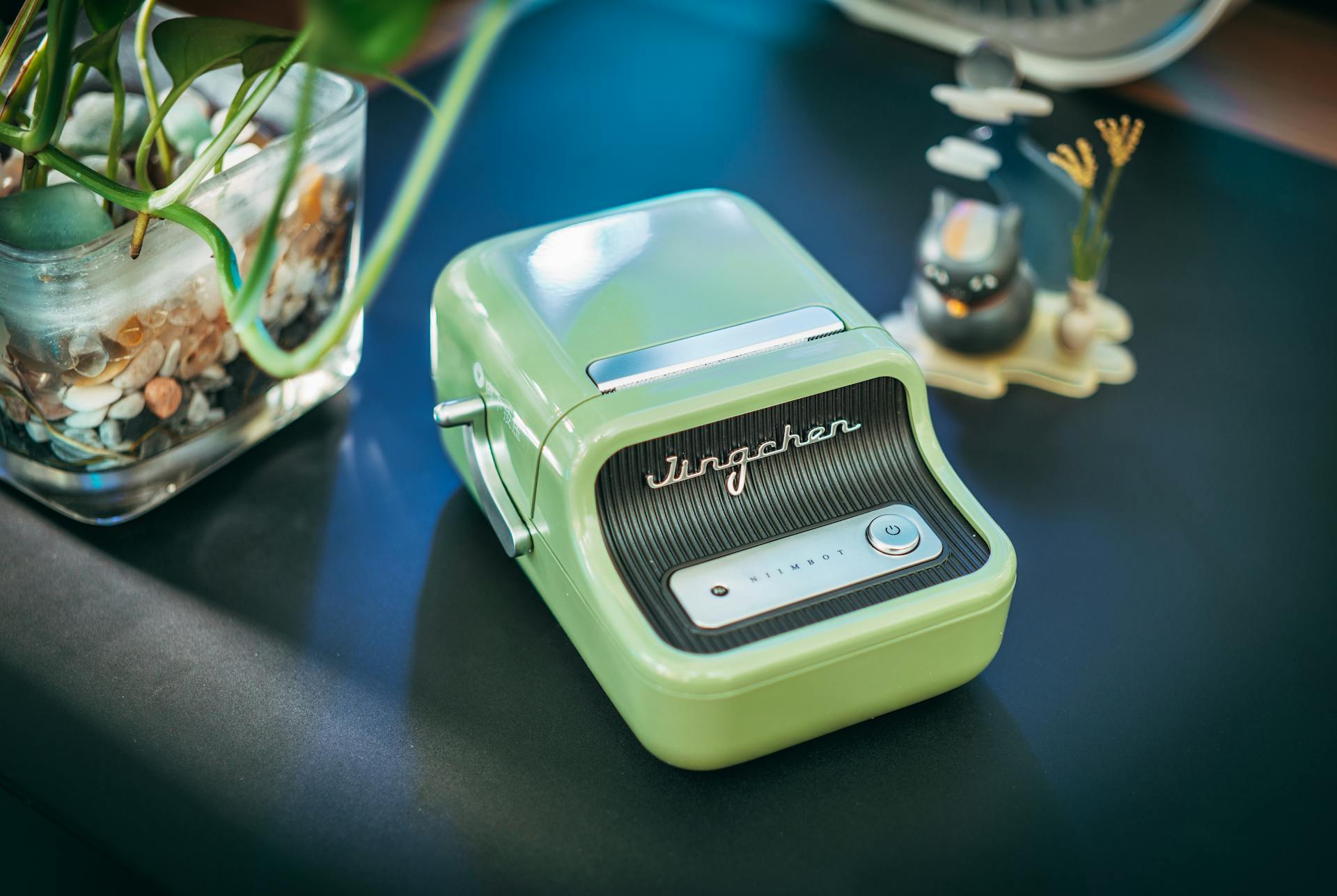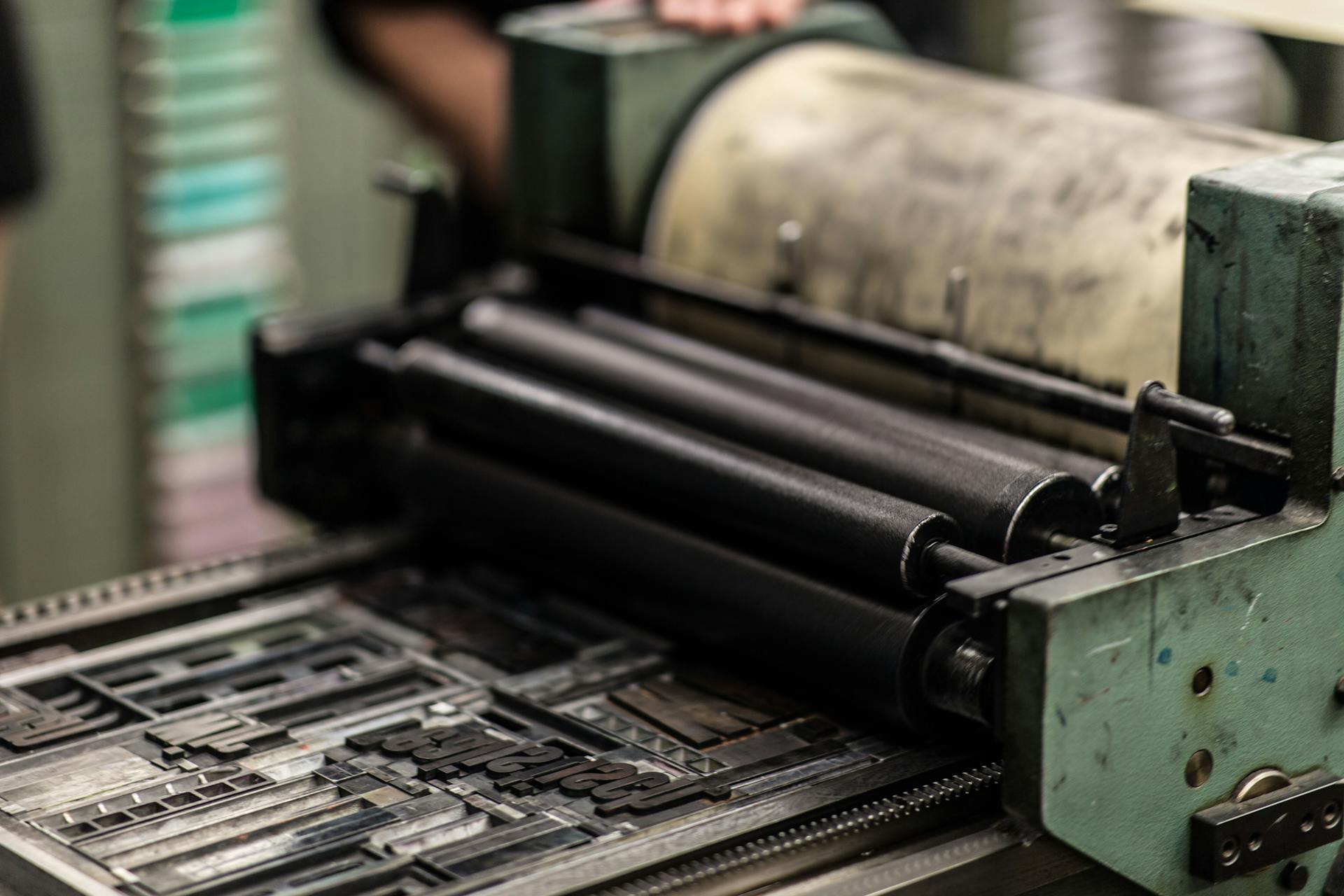
Palletizer machine types and industry applications vary widely, but they all share a common goal: to efficiently stack and secure products for easy handling and transportation.
There are several types of palletizer machines, including robotic palletizers, which use robotic arms to stack and secure products.
Robotic palletizers are ideal for high-speed applications, such as in the food and beverage industry, where they can handle up to 100 products per minute.
Another type of palletizer machine is the mechanical palletizer, which uses a series of mechanical arms to stack and secure products.
Mechanical palletizers are often used in the pharmaceutical industry, where they can provide high levels of precision and accuracy.
In addition to these types of palletizer machines, there are also semi-automatic and fully automatic palletizers, which offer varying levels of automation and control.
Semi-automatic palletizers are often used in small to medium-sized operations, where they can provide a cost-effective solution for palletizing products.
Fully automatic palletizers, on the other hand, are often used in high-volume operations, where they can provide high levels of efficiency and productivity.
For more insights, see: High Lift Pallet Truck 1000kg
What is a Palletizer Machine?
A palletizer machine is a machine that automates the process of stacking products onto pallets following a specific pattern.
It's a game-changer for improving the packaging process by making it faster, more consistent, and safer.
Palletizers are versatile and can handle a wide array of product types, from boxes and bags to barrels and bundles.
They're suitable for various industries, including food and beverage, pharmaceuticals, and manufacturing.
A palletizer works by receiving products on a conveyor belt, organizing them into the desired pattern, and then methodically stacking them on a pallet.
Advanced models can adjust to different pallet sizes and product dimensions, further optimizing the packaging line for different operational needs.
By streamlining the process of preparing goods for shipment, palletizers play a crucial role in logistics and supply chain management.
Their ability to automate stacking tasks boosts productivity and contributes to a smoother, more reliable flow of goods from manufacturers to consumers.
Robotic palletizer machines are an advanced automation system designed to efficiently organize and stack products onto pallets for storage, transportation, or distribution.
These machines are equipped with robotic arms and programming, allowing them to handle a range of products with precision and speed.
You might like: Palletizer Companies
Types of Palletizer Machines
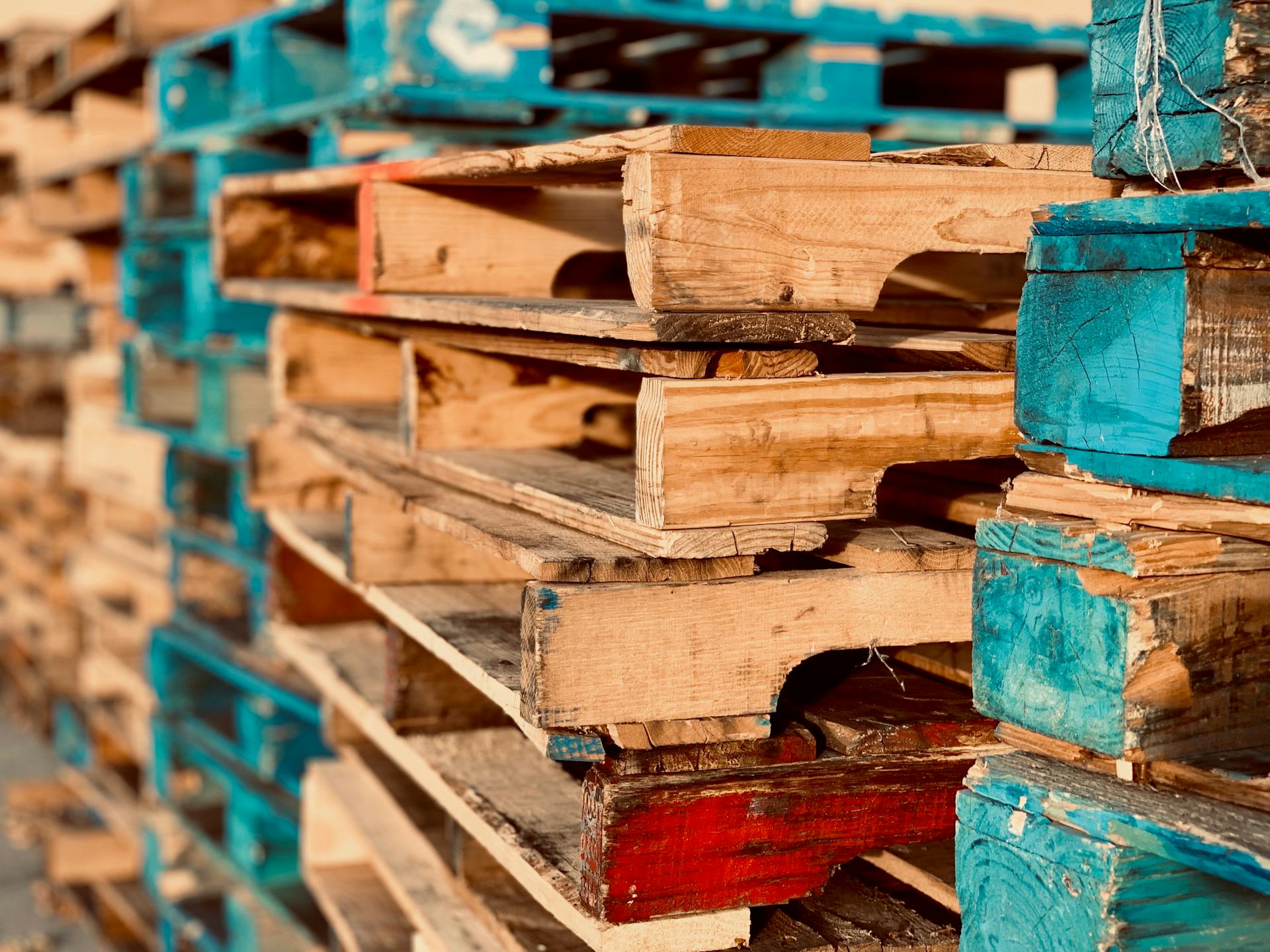
Palletizer machines come in two primary categories: conventional and robotic. Conventional palletizers are known for their speed and efficiency in environments with uniform product sizes.
Conventional palletizers utilize mechanical means to stack goods, making them a great option for high-volume production lines. They're perfect for businesses that need to move a lot of products quickly and efficiently.
Robotic palletizers, on the other hand, offer greater flexibility and precision. They employ advanced technology to handle a diverse range of product types and packaging configurations.
Robotic palletizers are ideal for businesses that need to adapt to changing product types and packaging configurations. They're perfect for e-commerce and retail operations, pharmaceutical factories, and custom packaging operations.
Here are some specific applications for robotic palletizers:
- E-commerce and Retail: Handle a wide variety of product types and sizes.
- Pharmaceuticals: Precise handling and flexibility due to changing package sizes and the delicate nature of products.
- Custom Packaging Operations: Quickly adapt to changing packaging needs or product designs.
Palletizers are essential tools in the logistics and supply chain industries, serving as the base for storing and transporting goods.
Conventional
Conventional palletizers are a staple in packaging lines, utilizing mechanical systems for operation.
They're perfect for environments with uniform product sizes and high-volume production lines, where speed is crucial.
Floor level palletizers are a cost-effective solution for many operations, operating at ground level and eliminating the need for structural changes to the facility.
This design makes them easily integrated into existing packaging lines and accessible for maintenance and monitoring.
High-level palletizers, on the other hand, function by stacking products from a height, allowing for quicker operation and handling a broader range of product sizes.
This flexibility makes them suitable for operations looking to boost productivity and accommodate diverse product dimensions.
Here are some industries where conventional palletizers shine:
- Food and Beverage Industry: Ideal for high-volume production lines where products like canned goods or bottles are uniform in size and shape.
- Manufacturing of Consumer Goods: Suitable for places producing large quantities of identical items, such as household products.
- Building Materials: Effective for stacking uniform items like bricks or tiles, where speed is crucial.
Palletizer Machine Industry Applications
Palletizer machines are used in various industries to handle a wide range of products. E-commerce and retail businesses can benefit from robotic palletizers that can handle diverse inventory types and sizes.
In the pharmaceutical industry, palletizers are suitable for factories that require precise handling and flexibility due to changing package sizes and the delicate nature of products.
You might like: B Pallets
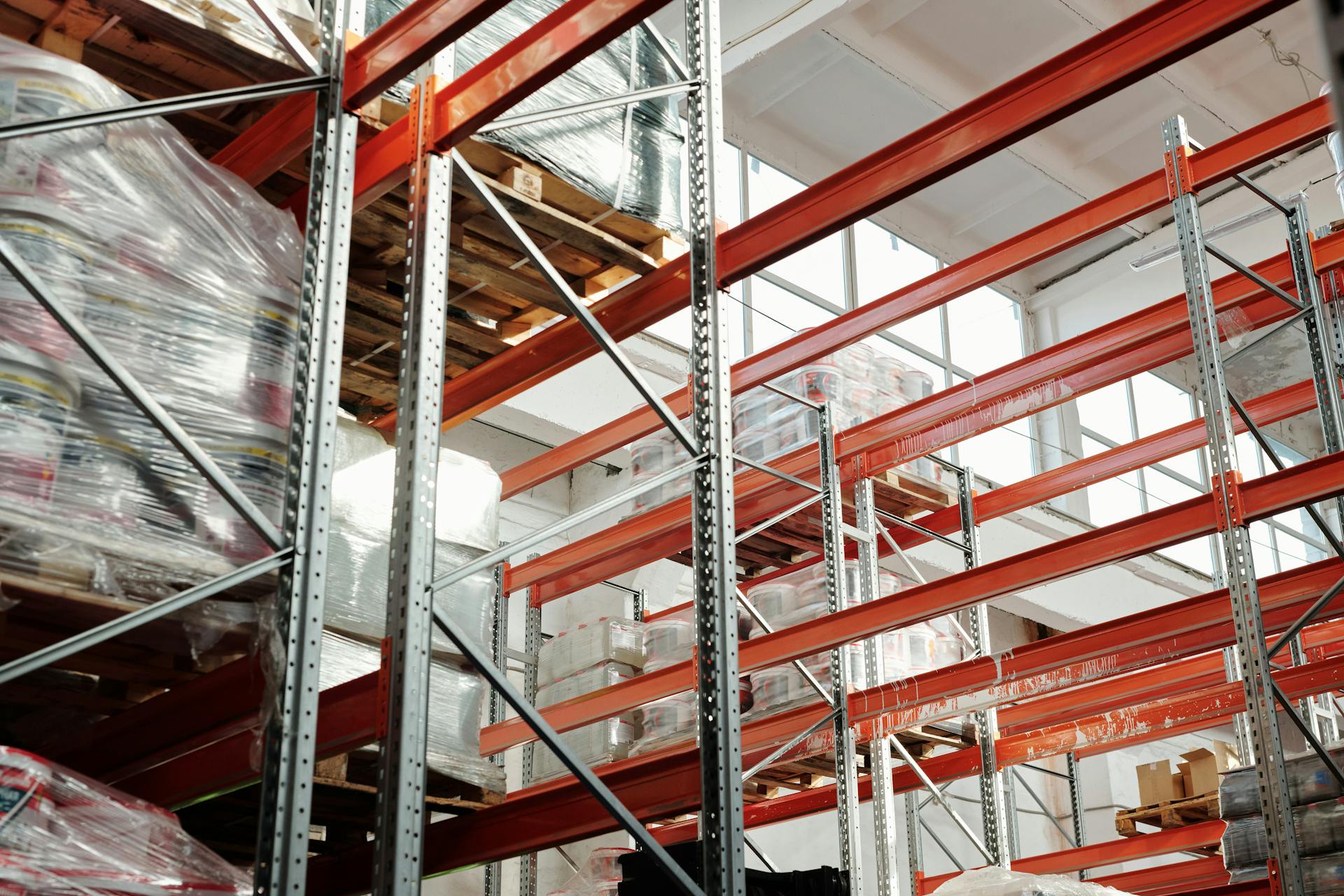
Custom packaging operations also appreciate palletizers that can quickly adapt to changing packaging needs or product designs, allowing for easy reprogramming of the robot for different tasks.
Here are some examples of palletizer applications:
- E-commerce and Retail: Offers the ability to handle a wide variety of product types and sizes.
- Pharmaceuticals: Suitable for factories that need precise handling and flexibility due to changing package sizes and the delicate nature of products.
- Custom Packaging Operations: Great for businesses that need to quickly adapt to changing packaging needs or product designs.
Phs: Stretch Hooding
The PHS is a game-changer in the palletizing industry, as it combines two machines in one, a low-level modular palletizer and an automatic stretch hooding machine.
This innovative design allows for efficient and streamlined production, reducing the need for multiple machines and increasing productivity.
The PHS can palletize and stretch hood in one machine, making it a convenient and space-saving solution for companies looking to optimize their packaging operations.
By integrating these two functions, the PHS can help reduce labor costs and improve overall efficiency in the packaging process.
For more insights, see: Stretch Wrap Machine Repair
Building Materials-Industry (PLS-B)
The Building Materials-Industry (PLS-B) layer palletizer is a beast of a machine. It can palletize bags of all usual formats and weights.
The PLS-B is designed to handle high volumes, with a palletizing speed of up to 5000 bags per hour. This level of efficiency is crucial for meeting the demands of the building materials industry.
Readers also liked: Bags on Pallets
The PLS-B is a reliable and robust machine that can be trusted to perform consistently. Its layer pattern palletizing system ensures that products are stacked stably and evenly.
Whether you're working with large or small bags, the PLS-B can handle it all. Its flexibility makes it an ideal solution for building materials manufacturers.
Palletizer Machine Options and Specifications
Palletizer machines come in various types, each suited for different industries and needs. Cartesian palletizers are ideal for high intensity work speed and high positioning accuracy, making them suitable for a wide range of products.
Options for palletizer machines include multiple sheet dispensers, polar packages for -20ºF environments, and wash-down parts for easy cleaning. Integrated pallet stretch wrappers can provide load stabilization, while lift-up rakes or push-over devices can increase speeds.
The specifications of palletizer machines vary, but typical footprints can range from 252" L x 180" W x 180" H, with case dimensions of 18 L" x 14" W x 12" H. Pallet dimensions can be up to 48" x 40" with a height of up to 9', and a weight of 60 lb.
Safe and Performant
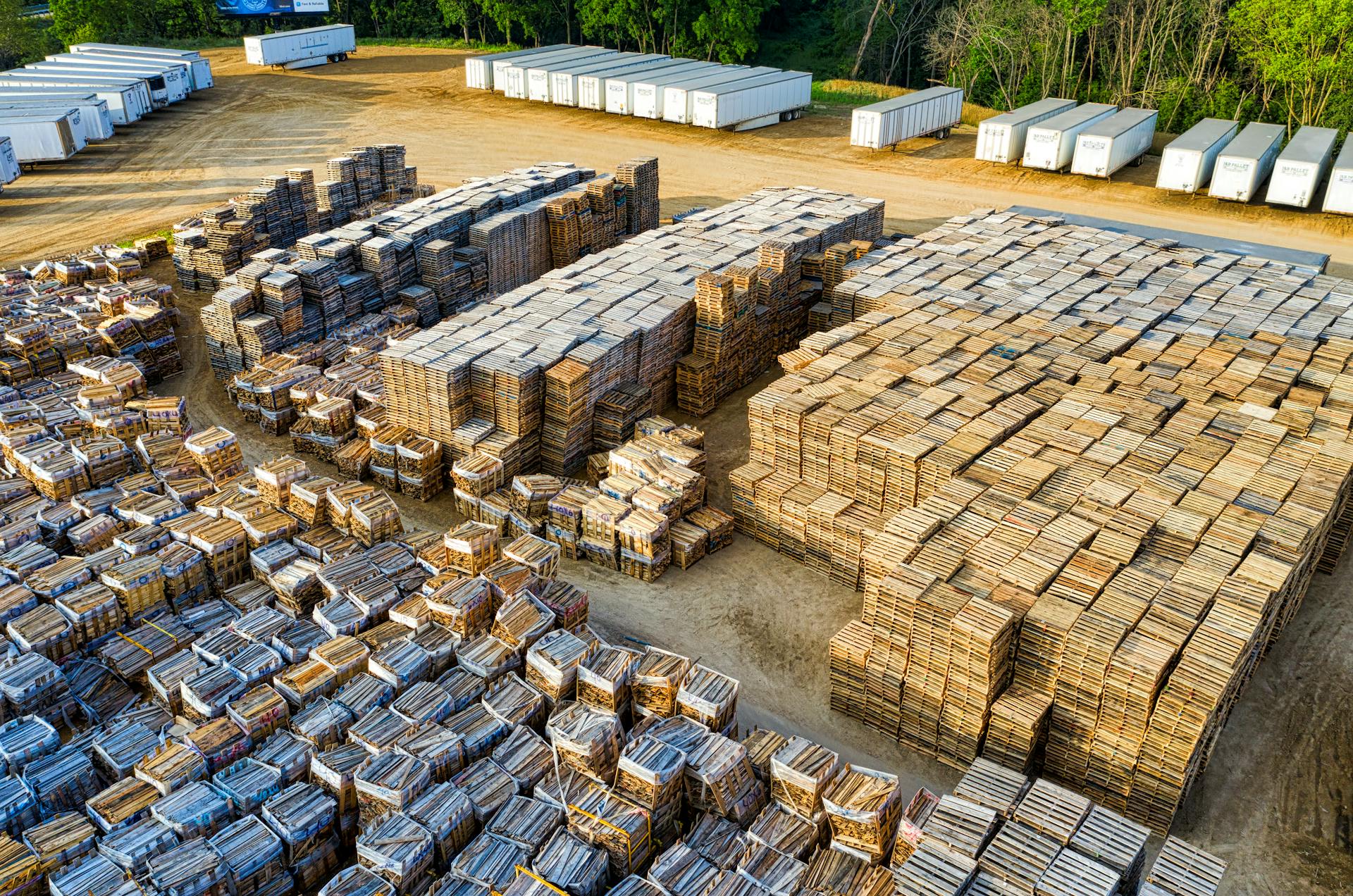
When choosing a palletizer machine, safety and performance are top priorities. A key feature to look for is the use of VFD motors, which enable gentle product handling and quiet stacking operation.
VFD motors are designed to minimize noise and ensure a smooth operation, making them ideal for applications where product integrity and operator comfort are crucial.
Fully automatic pallet dispensers are another safety feature worth considering. These dispensers minimize human intervention, increasing throughputs and reducing the risk of accidents.
Here are some key safety features to look for in a palletizer machine:
- VFD motors for gentle product handling
- Fully automatic pallet dispenser
- Easy access for maintenance and operation
- Category 3 and Performance Level D safety components
These features work together to create a safe and efficient palletizing process, reducing the risk of accidents and downtime.
Optimized Design
When designing a palletizer machine, it's essential to consider the pallet-entry orientation. You can choose to lead with either the narrow edge or the wide edge, which can affect the overall efficiency of the machine.
Leading with the narrow edge can provide a tighter fit, reducing the risk of pallets shifting during the palletizing process. This can be especially important in high-speed applications where precision is key.
Explore further: Narrow Electric Pallet Jack
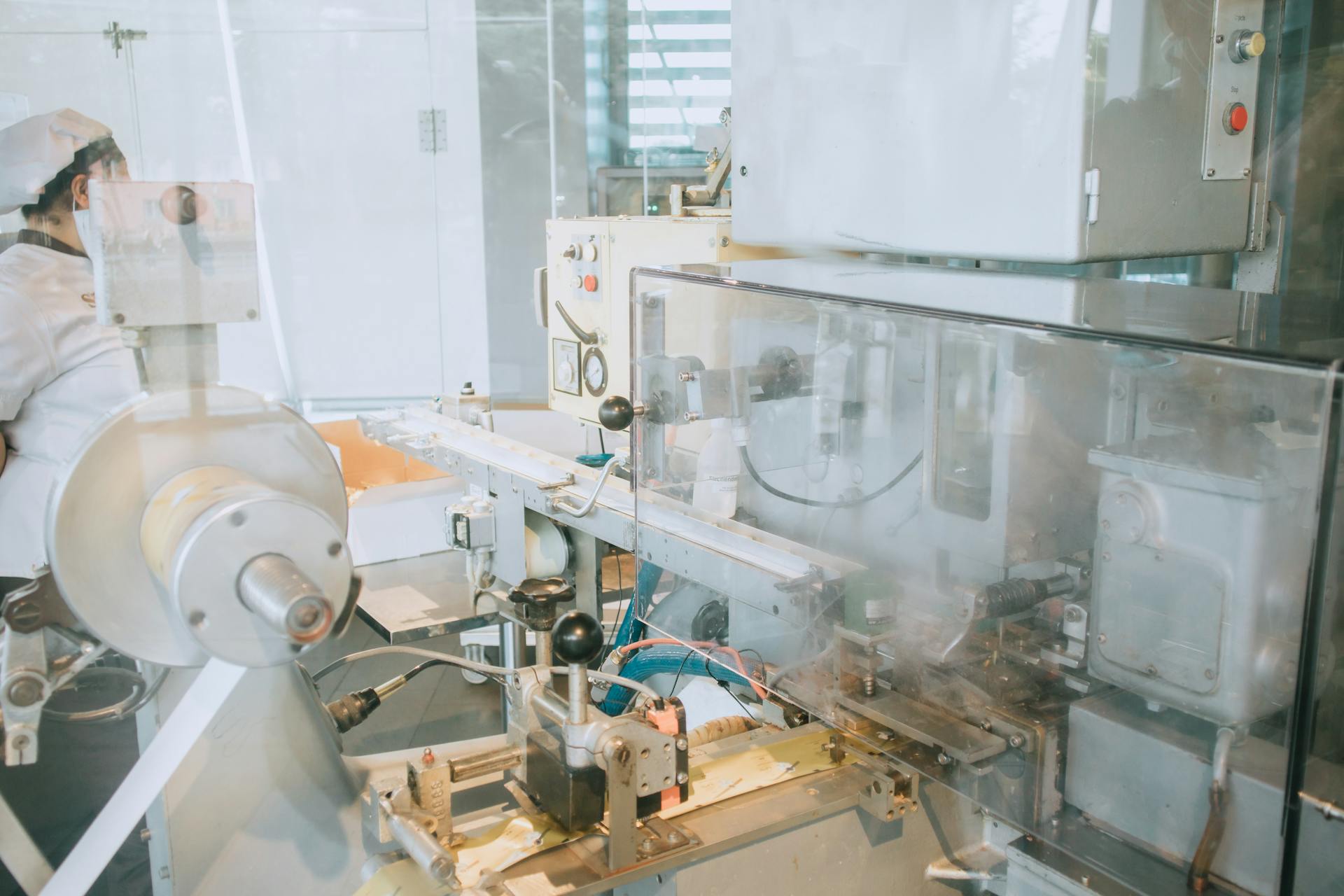
A 4,000 lb-capacity elevator is a common feature in many palletizer machines. This capacity is designed to handle heavy loads with ease, and the use of tension springs helps to minimize loose chains and promote durability.
Fast installation without excavation or foundation required is also a significant advantage of many palletizer machines. This can save time and money on setup and can get your production line up and running quickly.
Worth a look: Pallet Truck Capacity
Options
A palletizer machine is a crucial piece of equipment for any production line, and understanding the options available can make all the difference. With so many different types of palletizers on the market, it's essential to know what to look for.
Multiple sheet dispensers are a great option for those who need to handle different products on different pallets. This feature allows for easy switching between products, reducing downtime and increasing efficiency.
Polar Package for -20ºF environment is a specialized option for those who need to palletize products in extreme cold temperatures. This feature ensures that the palletizer can withstand the harsh conditions and continue to operate smoothly.
For another approach, see: What Is an In-line Palletizer
Wash-down parts for easy cleaning are a must-have for any production line that handles food or pharmaceutical products. This feature makes it easy to clean the palletizer and prevent contamination.
Integrated pallet stretch wrapper for load stabilization is a great option for those who need to ensure that their pallets are secure and stable. This feature wraps the pallet in plastic, preventing items from shifting during transport.
Lift-up rake or push-over device for higher speeds is a great option for those who need to increase their production speed. This feature allows the palletizer to move quickly and efficiently, reducing downtime and increasing productivity.
Additional pallet dispensers can be added to the machine to run different products on different pallets. This feature is especially useful for companies that produce multiple products.
Adjustable machine height allows you to build taller loads, which is essential for companies that need to palletize large or heavy items. This feature ensures that the palletizer can handle any load, no matter the size.
Here are some key features to consider when choosing a palletizer machine:
These features can make a huge difference in the efficiency and productivity of your production line. By choosing the right palletizer machine, you can ensure that your products are handled with care and precision.
Specifications
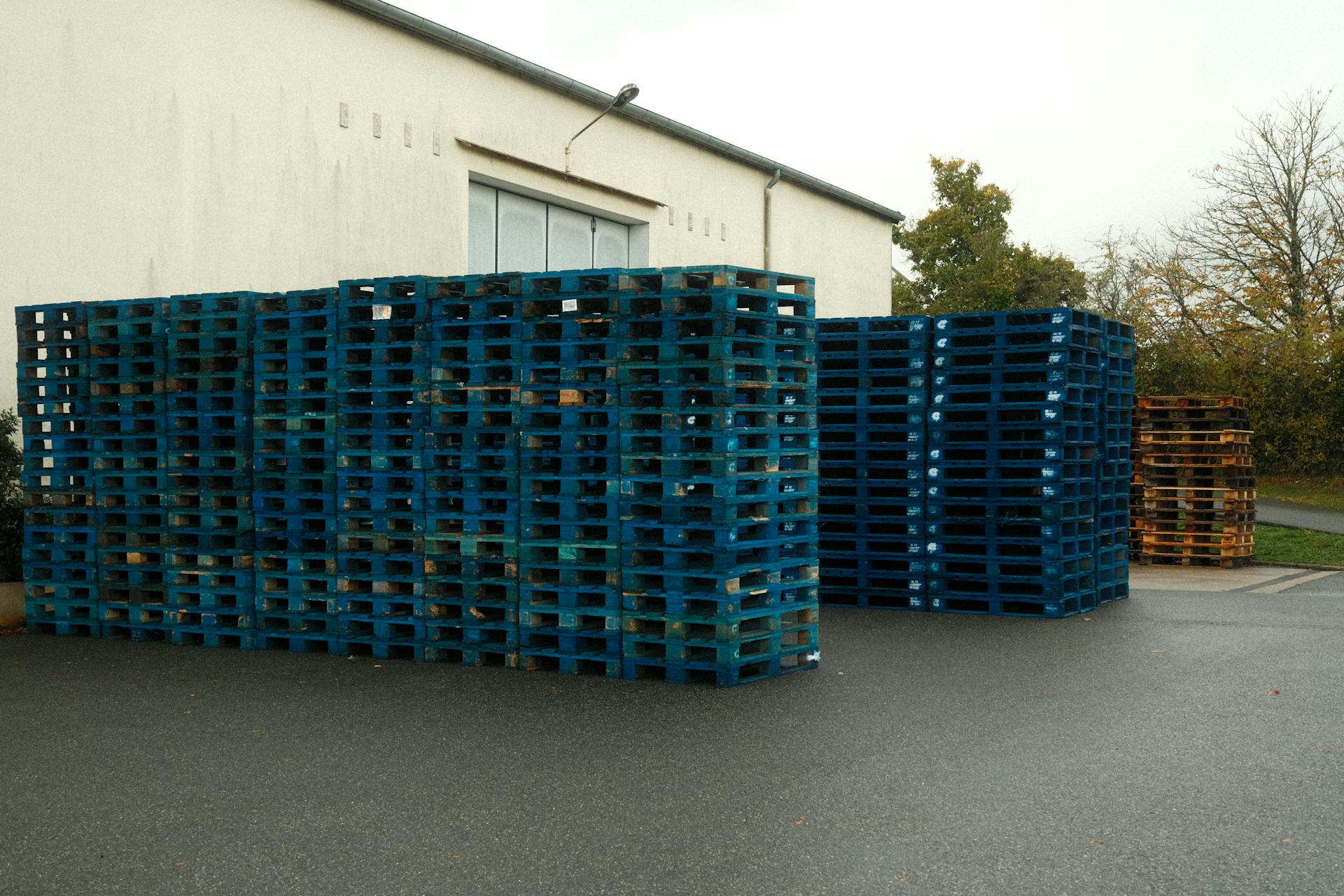
The palletizer machine's footprint is quite substantial, measuring 252" L x 180" W x 180" H (6400 x 4572 x 4572 mm) excluding conveyors.
The machine's case dimensions are relatively compact, at 18" L x 14" W x 12" H (457 x 355 x 304 mm).
The maximum weight of the machine is 50 pounds (22 kg).
A standard pallet measures 48" x 40" (1219 x 1016 mm) in size, and can weigh up to 60 pounds (27 kg) with a height of up to 9 feet (2743 mm).
The pallet magazine capacity is quite impressive, with a standard capacity of 10 to 12 pallets and an option for 20 to 25 pallets.
The machine requires a 230/460V / 3ph / 60hz electrical connection to operate.
It's essential to keep the machine within a temperature range of 40 °F to 95 °F (5 °C to 35 °C) to ensure optimal performance.
A unique perspective: Which End of Pallet Industry Standard for Lifting Pallets Forklifts
High-Performance Transport
High-performance palletizers are a game-changer for optimal transport, providing a dependable and competent solution for palletizing, wrapping systems, and secure handling of products.
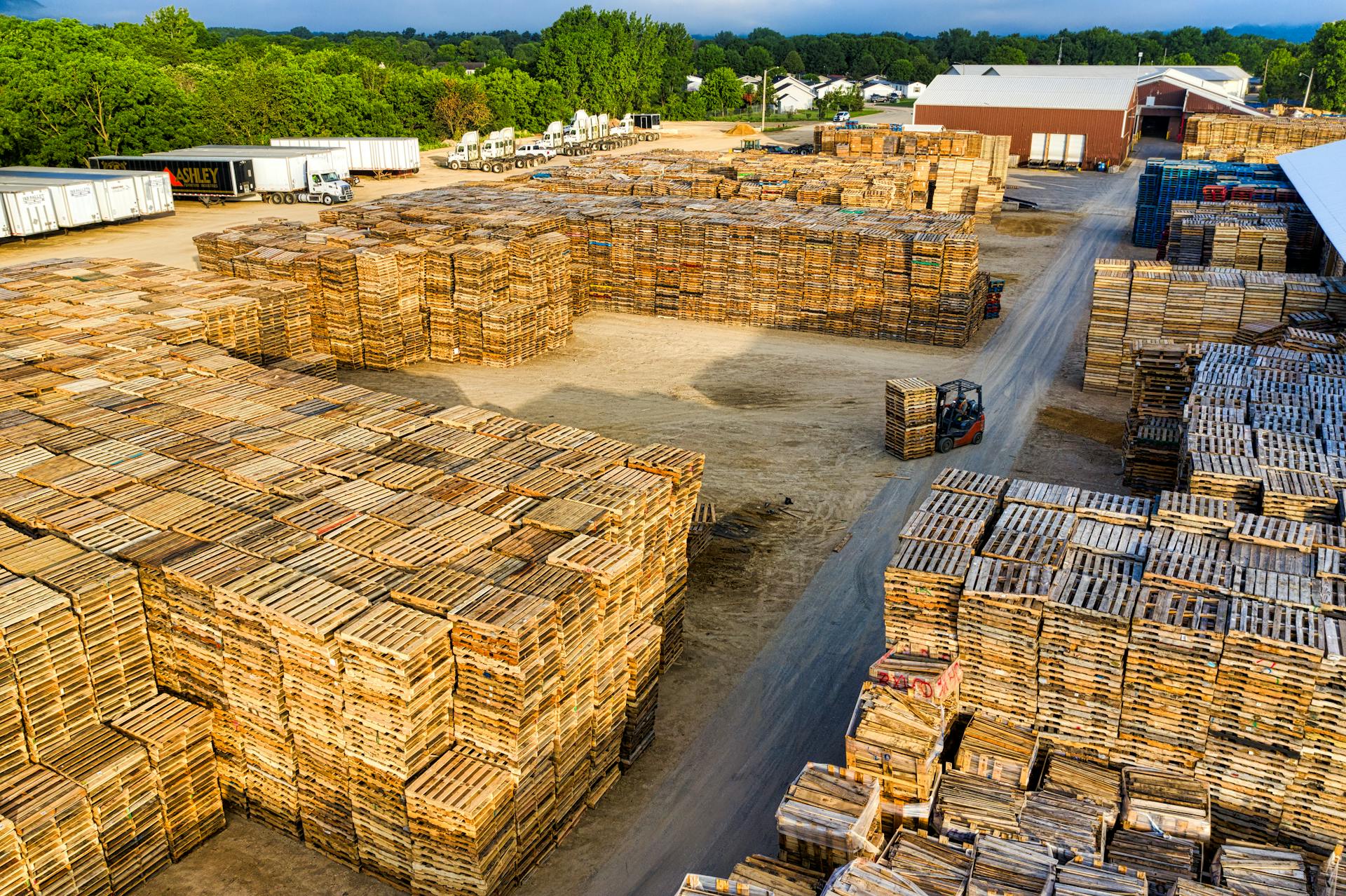
Möllers Packaging Technology is a trusted partner for high-performance palletizers, offering flexible and efficient formation of stable layers of wrapped goods.
Optimal load security is the top priority, ensuring that products are safely transported from A to B.
The employment of palletizing systems demands flexibility, and Möllers Packaging Technology delivers with their high-performance solutions.
If this caught your attention, see: Electric High Lift Pallet Truck
Palletizer Machine Benefits and ROI
Robotic palletizers bring a significant increase in efficiency and productivity, allowing businesses to meet production demands efficiently and maintain a competitive edge in the market.
By automating palletizing tasks, businesses can achieve substantial savings on labor costs over time, which can be redirected to more complex and revenue-generating tasks.
The improved accuracy of palletizing operations also reduces product waste and minimizes losses, contributing to higher customer satisfaction and supply chain optimization.
The reduction in errors and improved quality of goods also lead to reduced downtime and increased productivity, making the implementation of a robotic palletizer a strategic investment with compelling financial returns.
Consider reading: Vacuum Palletizing
Benefits of a

The benefits of a palletizer machine are numerous and can greatly impact your business's efficiency and productivity. A robotic palletizer can handle a wide variety of product types and sizes, making it ideal for businesses with diverse inventories.
One of the most significant advantages of a palletizer machine is its ability to operate around the clock, tirelessly handling repetitive palletizing tasks with precision and speed. This translates to a substantial boost in overall output, allowing businesses to meet production demands efficiently and maintain a competitive edge in the market.
A robotic palletizer can significantly reduce manual labor and associated costs, allowing you to minimize your reliance on manual labor. This can lead to reduced costs, improved workplace safety, and the reallocation of human resources to more complex roles within the organization.
The accuracy of palletizing operations is also improved with robotic palletizers, which are equipped with vision systems and precise programming. This reduces errors, minimizes the risk of damage, and contributes to higher customer satisfaction, waste reduction, and supply chain optimization.
Additional reading: Palletizing for Bags
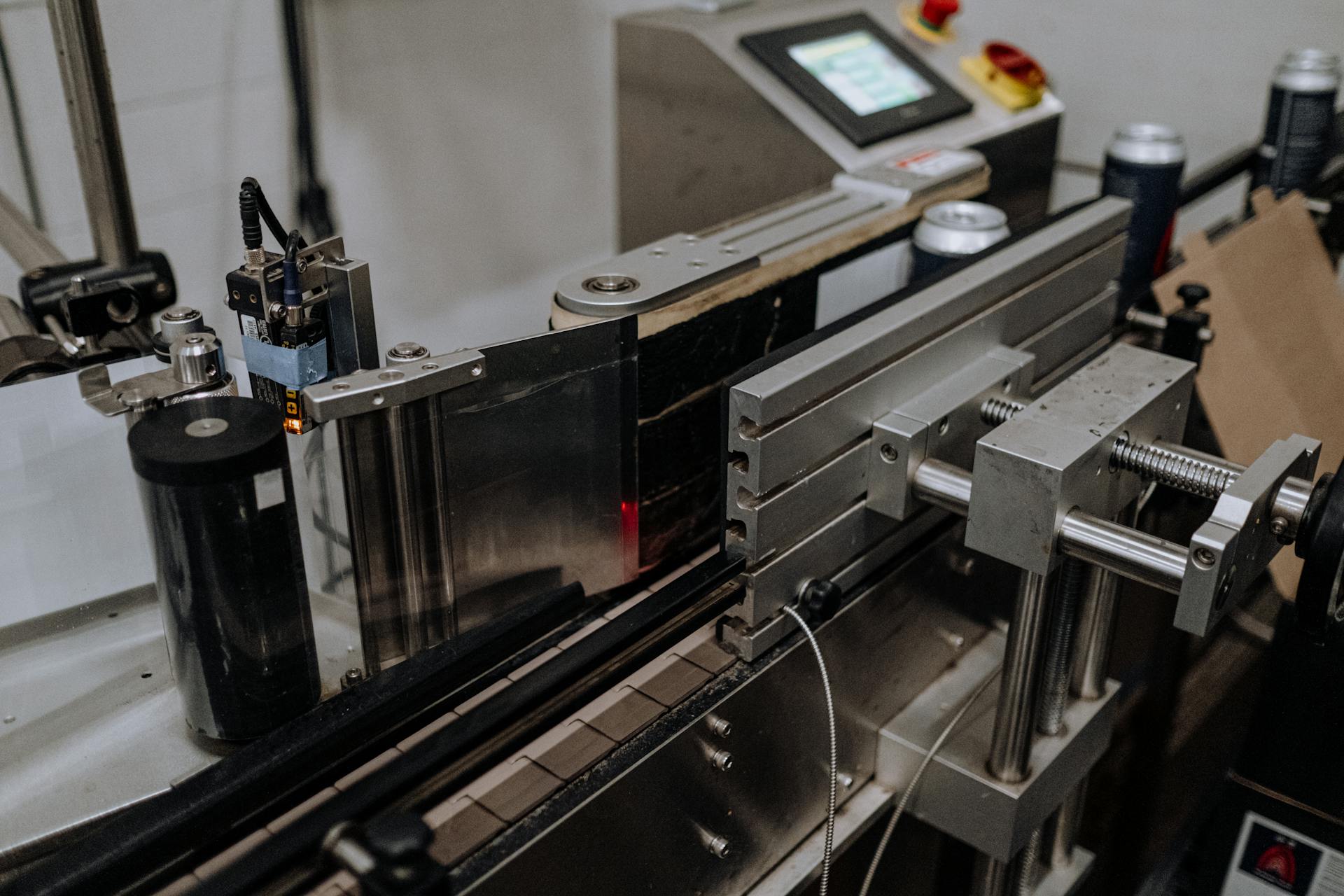
Here are some key benefits of a palletizer machine:
- Significant reduction in labor costs
- Improved accuracy in palletizing operations
- Increased efficiency and productivity
- Reduced product waste and losses
- Ability to reallocate human resources to more complex tasks
A palletizer machine can also help reduce downtime, enhance product quality, and provide a strategic investment with compelling financial returns. By automating palletizing tasks, businesses can achieve substantial savings over time and move people to more complex and revenue-generating tasks.
Advantages of Plants
Investing in a palletizer machine can bring significant advantages to a plant. You can expect a reduction of personnel expenses by 70% and management cost savings of 35%. This can lead to a substantial reduction in accidents at work, ensuring safety for the worker in the handling of materials.
A palletizer machine can significantly increase productivity by 30% as there's no need for staff supervision. This means you can achieve certain execution times every time. By automating the palletizing process, you can also optimize space to its maximum capacity.
Here's a breakdown of the benefits:
- Reduction of personnel expenses by 70%
- Management cost savings of 35%
- Reduction of accidents at work
- Safety for the worker in the handling of materials
- Increased productivity by 30%
- Always certain execution times
- Maximum space optimization
Palletizer Machine History and Technology
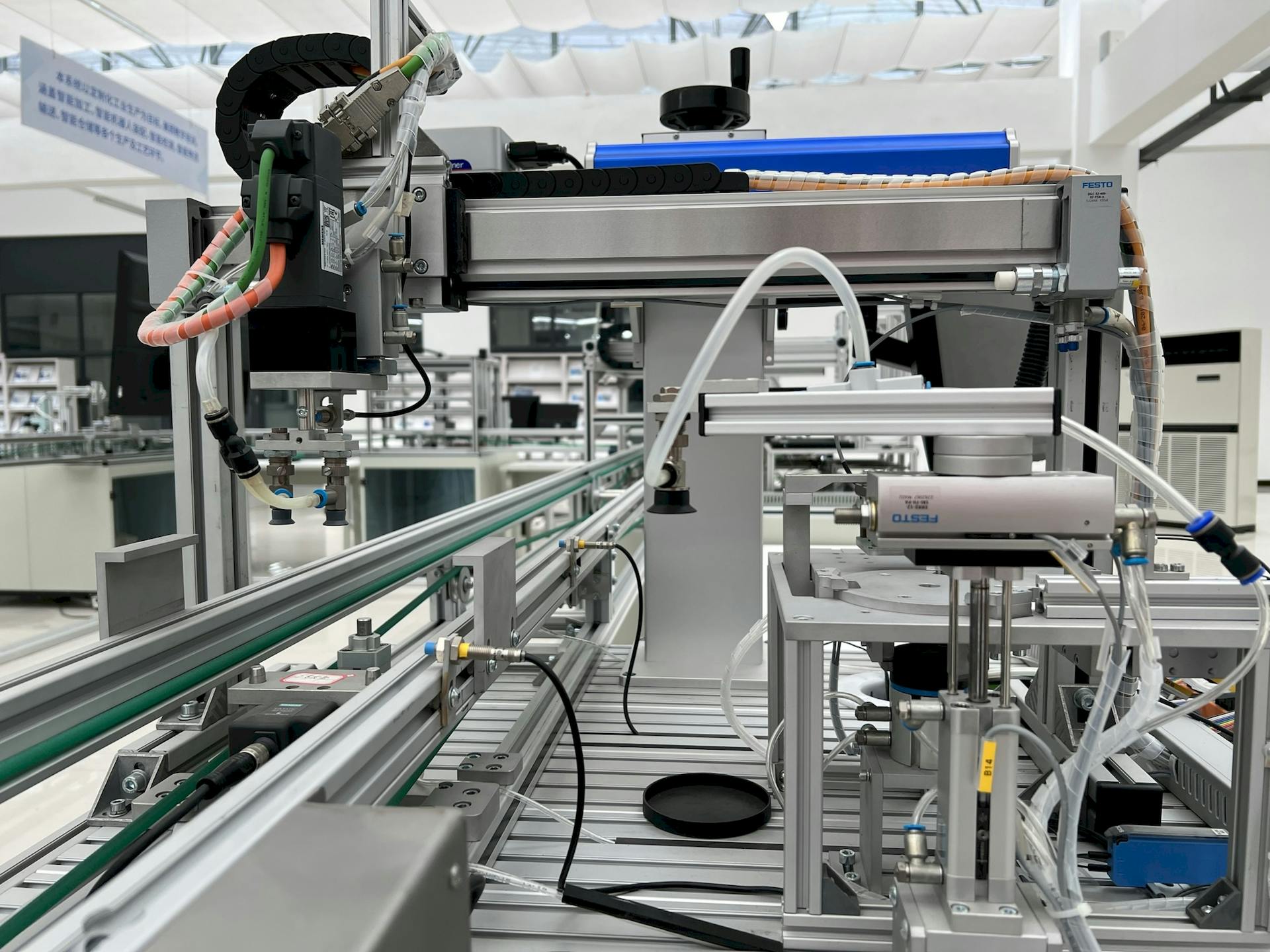
Palletizer machines have a rich history that dates back to the late 1940s. They were first introduced to enhance efficiency and safety in the food and beverage sector.
These machines revolutionized the packaging industry by automating the process of stacking goods onto pallets. They quickly became essential across various industries due to their ability to speed up the packaging process and reduce manual labor.
The advent of palletizers marked a huge leap forward in logistics and supply chain management, allowing for faster production lines, decreased risk of worker injury, and improved load stability during transport.
Today, palletizers are indispensable in sectors ranging from pharmaceuticals to construction, highlighting their critical role in modern manufacturing and distribution workflows.
Core Competence Layer
The core competence layer-palletizer is a game-changer in industrial sectors like fertilizers, chemicals, and petrochemicals, where it can process up to 3000 bags per hour.
This technology guarantees maximum secure transport by forming stable shipping units, which provides highest resistance to stress in global freight transport.
By creating stable shipping units, the layer palletizer ensures that goods arrive safely at their destination.
The layer palletizer of the series PLS-C is a prime example of this technology, achieving a maximum capacity of 3000 bags per hour.
Discover more: Pallet Freight Shipping
The History of
Palletizers were first introduced in the late 1940s and completely changed the packaging industry by automating the process of stacking goods onto pallets.
Initially developed to enhance efficiency and safety in the food and beverage sector, palletizers quickly became essential across various industries due to their ability to speed up the packaging process and reduce manual labor.
The advent of palletizers marked a huge leap forward in logistics and supply chain management, allowing for faster production lines, decreased risk of worker injury, and improved load stability during transport.
Over the years, technological advancements have led to the development of more sophisticated palletizing systems, including robotic palletizers, which offer greater flexibility and precision.
Today, palletizers are indispensable in sectors ranging from pharmaceuticals to construction, highlighting their critical role in modern manufacturing and distribution workflows.
Thanks to Effective Technology
Thanks to effective technology, palletizing has become a highly efficient process. Conventional palletizers are known for their speed and efficiency in environments with uniform product sizes, utilizing mechanical means to stack goods.
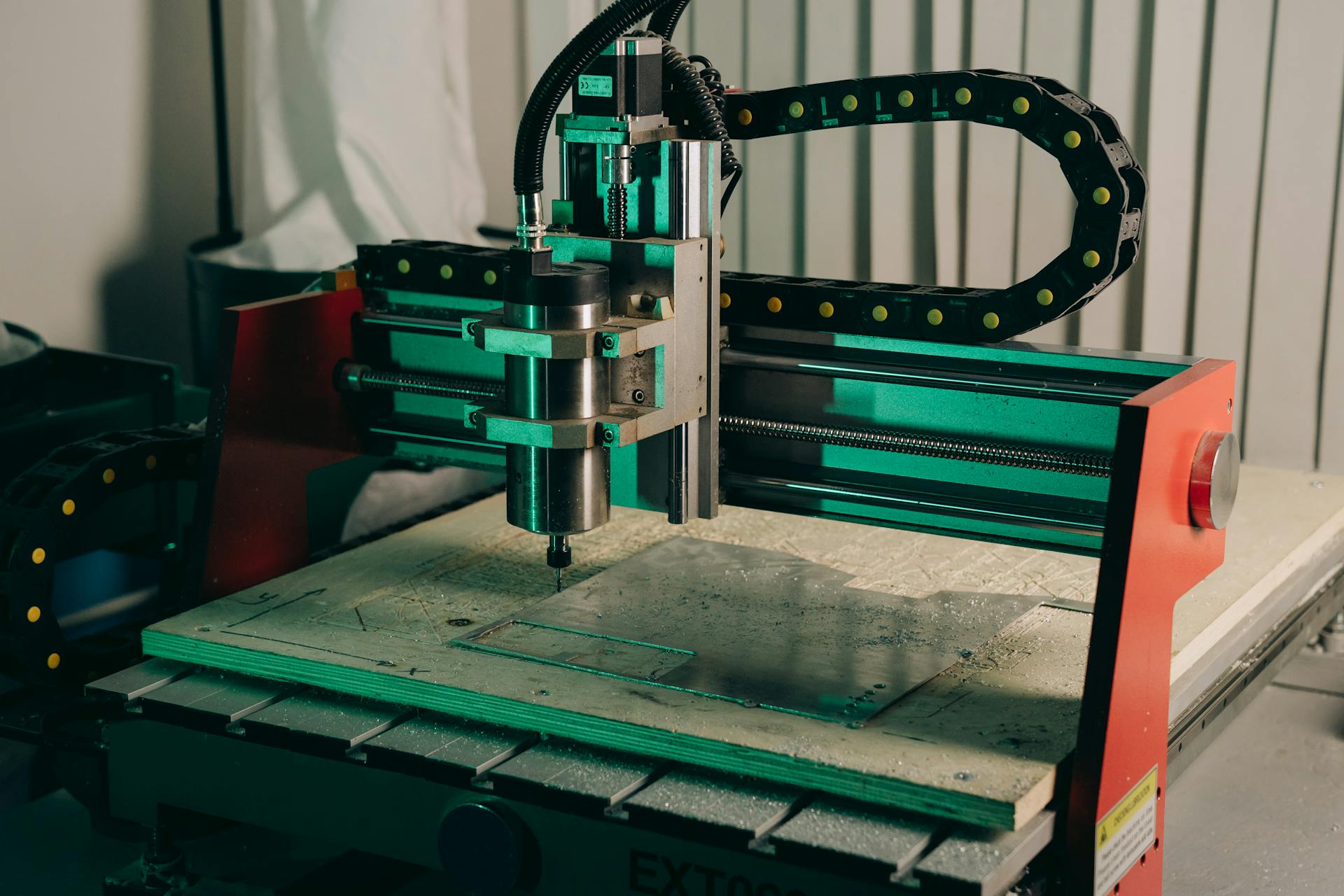
There are two main types of palletizers: conventional and robotic. Conventional palletizers are best suited for high-volume production lines, while robotic palletizers offer greater flexibility and precision.
Robotic palletizers can handle a wide variety of product types and sizes, making them ideal for businesses with diverse inventories. In the e-commerce and retail industry, robotic palletizers offer the ability to handle a wide range of product types and sizes.
In the pharmaceutical industry, robotic palletizers are suitable for factories that need precise handling and flexibility due to changing package sizes and the delicate nature of products. Custom packaging operations also benefit from robotic palletizers, which can quickly adapt to changing packaging needs or product designs.
Pallets are essential tools in the logistics and supply chain industries, serving as the base for storing and transporting goods. Fully-automatic palletizing systems offer companies maximum flexibility and can be switched to different product formats and pallets.
The machines function in an energy-saving manner, with low noise and high availability. An example of this is the articulated-arm robot, which impresses with its flexible adaptation to the conditions in the palletizing of products in industry.
A unique perspective: How Wide Is a Pallet Jack
Palletizer Machine Systems and Industries
Palletizer machines are used in various industries, including e-commerce and retail, where they can handle a wide variety of product types and sizes.
Robotic palletizers are particularly well-suited for businesses with diverse inventories, allowing them to adapt quickly to changing product demands.
In the pharmaceutical industry, palletizers must be precise and flexible due to the delicate nature of products and changing package sizes.
Custom packaging operations also benefit from robotic palletizers, which can be easily reprogrammed for different tasks and product designs.
Palletizing systems are not limited to these industries, as they can be applied to various sectors and meet the requirements of almost all industries.
The company behind these palletizing solutions has been a manufacturer of high-quality palletizing systems for over 65 years, known for their robustness, reliability, and performance.
Here's a breakdown of the industries that can benefit from palletizing systems:
- E-commerce and Retail
- Pharmaceuticals
- Custom Packaging Operations
These industries can take advantage of the gentle packed-material handling method, tailor-made solutions, high load security, and wide selection of palletizing systems and gripper devices offered by these palletizing systems.
A fresh viewpoint: Case Palletizing
Palletizer Machine in Confined Spaces

Palletizer machines are incredibly versatile, but did you know they can even thrive in tight spaces? The ROMEO Palletizing robot is a great example of this, showcasing its high-precision capabilities in confined spaces.
In a confined space scenario, a palletizing robot like the ROMEO can make a big difference. It's an all-rounder that can handle a variety of tasks with ease.
Low Level PFS: Special Tasks
Low Level PFS is perfect for special tasks, especially when you need to palletize with frequent product changes. It can handle capacities up to 1200 bags per hour.
In confined spaces, a low level palletizer like PFS is a great option because its slide plate functions at floor level. This design makes it easy to integrate into tight spaces.
For tasks that require a high degree of flexibility, the PFS is a top choice. Its ability to handle frequent product changes makes it an attractive solution for companies with diverse product lines.
Take a look at this: Low Profile Narrow Pallet Jack
Increase Safety
Safety is a top priority when working with palletizer machines, especially in confined spaces. Robotic palletizers are designed with built-in sensors and intelligent software that enable real-time monitoring of their surroundings.
These machines are equipped with features like collision detection and emergency stop functionalities, which act as safeguards, preventing accidents and minimizing the risk of damage to the equipment or surrounding infrastructure.
To ensure compliance with industry regulations, our machines are designed, built, and operated in accordance with industry standards. This commitment fosters a secure working environment and mitigates legal and financial risks associated with non-compliance.
In addition to internal safety mechanisms, robotic palletizers are designed for human-robot collaboration. They feature advanced technologies like force-sensing capabilities and responsive programming, which enable them to detect and respond to the presence of human workers in their vicinity.
Here are some key safety features of our palletizer machines:
- VFD motors for gentle product handling and quiet stacking operation
- Fully automatic pallet dispenser minimizes human intervention while increasing throughputs
- Category 3 and Performance Level D safety components
These features work together to create a harmonious interaction between human and machine in the industrial setting, enhancing efficiency while maintaining a high level of safety.
Romeo Robot in Confined Spaces
The ROMEO robot is a great example of a palletizing robot that thrives in confined spaces. It's an all-rounder that can handle high-precision tasks with ease.
In particular, the ROMEO robot excels in tight spaces, making it a valuable asset for companies with limited storage or production areas. Its design allows it to navigate through narrow aisles and corners with precision.
The ROMEO robot is equipped with a software-controlled gripper arm system that enables it to handle packed goods with care. It can create homogeneous layers on a pallet without stressing the products unnecessarily.
This gentle mode of operation is a key feature of the ROMEO robot, making it an ideal choice for companies that prioritize product safety and quality.
Palletizer Machine Comparison and Selection
The decision to use a palletizer machine depends on specific operational needs, including the nature of the products, the volume of production, and the amount of flexibility needed on the packaging line.
Robotic palletizers can bring advanced versatility to the process, allowing for more complex movements and the ability to handle a variety of tasks.
Kassow Robots offers a compelling solution with its 7-axis collaborative robot arm, which is highly beneficial in environments that need adaptability and precision.
Businesses looking to enhance efficiency and adaptability on their packaging lines may find robotic palletizers to be a great choice.
The right palletizer machine can make a big difference in productivity and efficiency, so it's essential to choose the one that best fits your specific needs.
Palletizer Machine Overview
Palletizer machines are designed to handle a wide variety of product types and sizes, making them perfect for businesses with diverse inventories.
In the e-commerce and retail industry, palletizer machines offer flexibility and precision, allowing them to efficiently handle different products.
Palletizer machines are suitable for factories that need precise handling and flexibility due to changing package sizes and the delicate nature of products, as seen in the pharmaceuticals industry.
The custom packaging operations industry benefits greatly from palletizer machines, as they can quickly adapt to changing packaging needs or product designs.
Here are some key applications of palletizer machines:
- E-commerce and Retail
- Pharmaceuticals
- Custom Packaging Operations
Frequently Asked Questions
What does a palletizer operator do?
A palletizer operator oversees the palletizing stage of a workflow, ensuring production runs smoothly and efficiently. They monitor quality, control machine settings, and intervene when necessary to prevent errors or downtime.
Sources
- https://www.kassowrobots.com/blog/what-is-a-palletizer
- https://www.moellers.com/en/products/palletizer/
- https://www.ptchronos.com/products/palletizing/palletizer-machines/automatic-high-level-case-palletizer
- https://www.mftecno.com/us/case-history/palletizer-the-complete-guide/
- https://www.basilius.com/blog/improve-operations-with-a-robotic-palletizer-machine/
Featured Images: pexels.com
